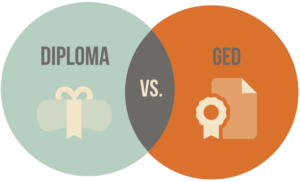
Diploma Vs. GED

What exactly is the difference between a diploma and a GED?
A high school diploma is the gold standard to demonstrate you have developed the skills acquired in high school. Here are some of the most important differences to consider:
- According to the US Bureau of Labor Statistics, people with a high school diploma earn $179 more per week on average than those with a GED. That’s about $9,300 dollars more a year you could earn just by getting your diploma!
- A GED does not hold the same value with employers as a high school diploma. According to the Bureau, people who have a GED have an unemployment rate of 11% whereas people with a high school diploma are only at 7.5%.
- A high school diploma is FREE!
Earning your high school diploma may be easier than you think. Your Youth Academic Navigator will be right by your side throughout your journey, offering guidance and encouragement. You have the potential!
High School Diploma |
GED |
|
Cost |
Free | $120 (4 tests @ $30 per test ) |
Individual Assistance |
Teachers, tutors, counselors available at school site and some community locations | On-line tutoring or in-person classes at community locations |
Time Requirements |
Most students take four years to earn a diploma but can continue up to age 21 | Metropolitan Community College is currently offering options to start GED testing only a few times a year; you may have to wait weeks/months or be put on a waiting list to start testing (or classes, if you’re not ready for testing); must be at least 16 years old |
Job Options |
Shows you finished what you started; eligible for 90% of available jobs | Available, but with potential stigma or doubt about qualities of persistence, motivation, and reliability |
Non-Academic Skills |
Four years of high school results in at least some development of “people” skills as well as classroom experience, which can help you in college or training programs | Limited |
Monthly Income |
$9,300 more per year on average than GED* | Limited |
Employment Value |
Unemployment levels at 3 to 4 points lower than GED* | Limited |
% Pursue Post-Secondary Education |
73%** | 43% |
% Obtain Bachelors Degree |
33%** | Less than 5% |
Military and Police Departments; Drop out rate |
Preferred by military branches and police departments; dropout rate of 25% for military | Not preferred by military branches or police departments; dropout rate of 45% for military |
*US Bureau of Labor Statistics
**US Census Bureau